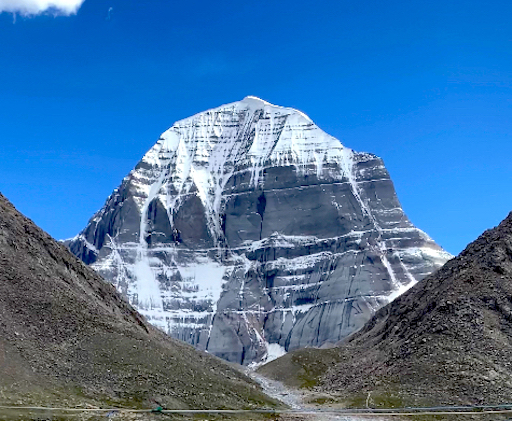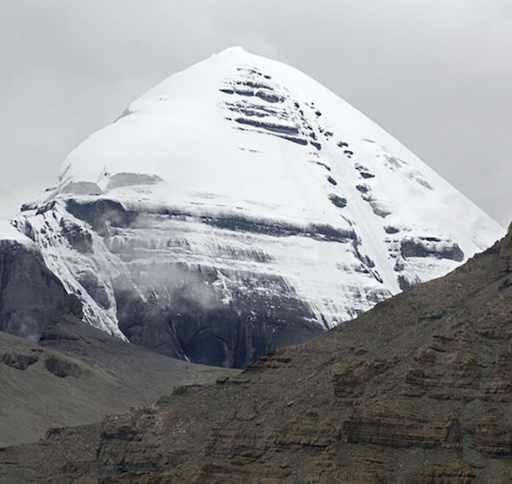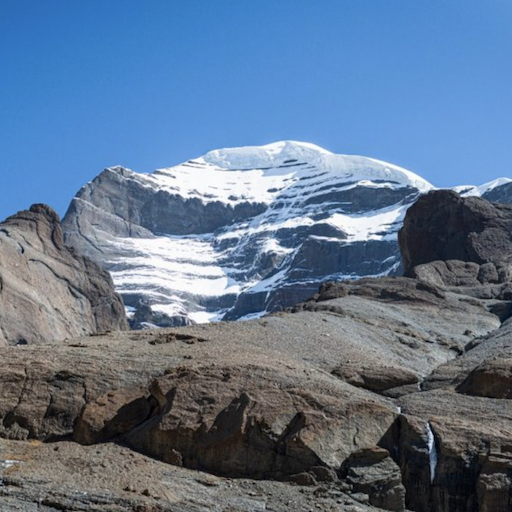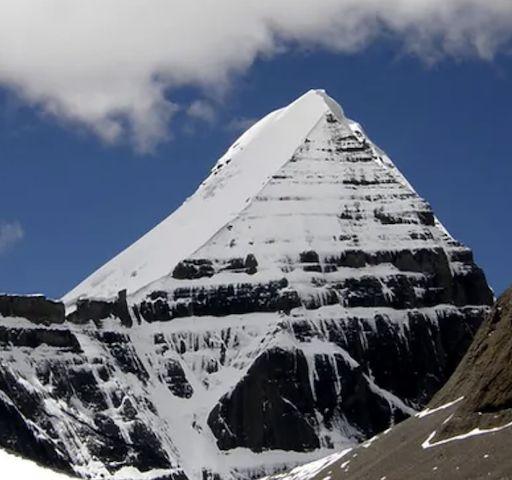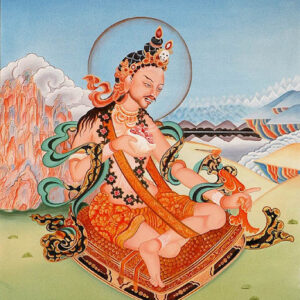This is mountain which is considered as the abode of Lord Shiva. It is also the important pilgrimage for Tibetan Buddhists, Jains, and Bons.
There is space to sit and meditate. You can go into meditative states effortlessly here.
How to get there
Kailash mountain is 32 kms North of Manasoravar Lake.
Map: https://maps.app.goo.gl/Pn3EPzpHm2xUC4xSA
Mount Kailash – The Abode of Shiva
Sadhguru: My experience and understanding of Kailash is something that I can never articulate. For me it’s so big that I am willing to die for it. That’s all I can say. When the first Jain Thirthankar came here to Mount Kailash, his name was Rishabdev, he came here with a mission. He had heard much about it. So he thought he will grab all this knowledge and go out and do something with it. He was a being who was open and receptive to the whole process. After being touched by Kailash, instead of taking the knowledge and going and doing something, he decided to merge with the mountain. He became a part of it. No being who has tasted it to some depth will be spared that temptation. When you are in touch with it, you begin to think, “This is it, why not?” Everything else – all the petty goals that we have set for ourselves to do this and that – become meaningless. This is not a death wish. When the opportunity to become immortal is thrown at you, there is temptation. When the possibility of becoming a part of such a grand affair is opened, it becomes a temptation hard to resist.
Mount Kailash is a tremendous spiritual library. The Buddhists consider Kailash as the axis of the existence. In the whole area from the Far-east Asian countries to the Indian sub-continent to the Central-Asian countries, and even in spaces as far as the Middle East, Kailash has been held as a very sacred space for centuries. That awareness has dropped in the last one or two centuries because there is no active culture to keep it up, but even today there are small groups of people who are very much aware of this.
Starting from Shiva himself, many great beings chose to deposit and preserve their work in Kailash. Rishabadev, the saints of the Bon religion, two of the greatest Buddhist teachers, Agastyamuni, the Nayanmars, – all of them chose Kailash Parvat.
In the Hindu way of life, people say Kailash is the Abode of Shiva. In the yogic culture we do not see Shiva as a God. We see him as a man who was the first yogi or the Adiyogi. And he was the Adi Guru or the first guru. He was the first one to transmit the yogic science to his first seven disciples, who came to be known as the Saptarishis. Shiva is the greatest mystic that we have known. So when we say “Abode of Shiva,” it does not mean that if you dig in the rocks or look up in the clouds somewhere you will find him. It is because everything that he knew has been deposited in Mount Kailash in a certain energy form. He chose this peak as a scaffolding for his knowing. The knowledge and the capability that Shiva was, all that is very alive and accessible at Kailash. So, starting from Shiva himself, many great beings chose to deposit and preserve their work in Kailash. Rishabadev, the saints of the Bon religion, two of the greatest Buddhist teachers, Agastyamuni, the Nayanmars, – all of them chose Kailash Parvat as a place to preserve their work. Unfortunately, for most mystics on the planet, if they get to share one or two percent of their work with people around them, they are very fortunate. Most of them don’t even get to do that. So they always chose to deposit their work in some space that is not too frequented by human beings, but at the same time it’s accessible for those who wish to go. Kailash is such a place. It is not totally inaccessible but it’s hard enough to discourage a lot of people. There are many places like this in India.
There have been many places where mystics deposited their work, but Kailash has been the place.
Unfortunately, preparing people to receive what is known by a certain opening up of your own perception, doesn’t happen frequently enough. Whatever work you do with people around you constantly gets limited because of social restrictions to start with, and then by individual problems that people have – psychological and physiological limitations and karmic bondages. It is rare to be able to prepare one or two people who will be able to receive everything that you know. Very few masters have ever been that fortunate. The rest have to work around people and around the social norms and limitations. So, not even a small percentage of what they know gets actually transmitted or shared. They find rocks very receptive. There have been many places where mystics deposited their work, but Kailash has been the place. In terms of the volume and the variety that has been deposited in Kailash, it is the place.
The very idea behind a pilgrimage is fundamentally to subdue the sense of who you are. The idea of a trek or a mountaineering feat is always towards a sense of achievement to make yourself bigger than who you are, but the idea of a pilgrimage is to subdue yourself. It is to become nothing in the process of just walking and climbing and subjecting yourself to various arduous processes of nature. So these places of pilgrimage in the ancient past were always located in such places where a person has to go through a certain amount of physical, mental, and every kind of hardship to get there, so that in the process he becomes less than who he thinks he is right now. Today things have been made much comfortable. We are flying up and then driving down and just walking a little bit…
The fundamental idea of pilgrimage becomes much more relevant to modern societies than it was to the ancient ones. This pilgrimage in terms of the destination, probably is the greatest that one can make.
Physically we are much weaker human beings than what we used to be a thousand years ago. It is not an evolutionary thing. It is something social which has happened to us because somewhere we do not know how to make use of the comforts and conveniences that man’s ingenuity has brought into our lives. We have not used the comforts and conveniences of human ingenuity in the direction of our wellbeing. We have used it to make ourselves weaker, more difficult with ourselves and with the surroundings in which we exist. The planet or what the planet has to offer to us is becoming more difficult to human beings simply because of the comforts and conveniences that have been offered. So the fundamental idea of pilgrimage becomes much more relevant to modern societies than it was to the ancient ones. This pilgrimage in terms of the destination, probably is the greatest that one can make.
Kangrinboqe Peak
The Kangrinboqe Peak is one of the centers of Tibet Buddhism, Hinduism and the Bon. It is the summit of the Gangdese Mountains, and enjoys worldwide fame is far behind Qomolangma (Mount Everest). However, geographical altitude matters little in the realm of spirituality. The Tibetans call the peak “Kangri,” which means “treasure of the snowy mountains.” In Buddhism and Hinduism, this peak occupies a position as important as the Mandala, or the center of the universe. It is also the “Heaven of Siva” in Hinduism.
The peak resembles “an olive towering into the sky, with a seven-colored round crown and surrounded by an eight-petal lotus.” The whole mountain seems to be made of crystal, looking like a jade-inlaid ice sculpture of extremely skillful craftsmanship.
Legend has it that when the founder of Buddhism, Sakyamuni, was alive, guardians of all directions, Bodhisattvas, heavenly gods, human beings, Lhamayin and musicians from heaven gathered around the Kangrinboqe Peak in the year of horse, so the year of horse has become the animal-symbolized year when the mountain turned holy. It is said that the master of Tibetan Buddhism Milareba was there, practicing Buddhism, doing missionary work and displaying his power. All these make the Holy Mountain even more mystical.
It is said that pilgrims can wash away their lifetime sins after traveling once around the mountain; they can be exempt from the sufferings of Hell during the 500 samsara if they travel 10 times around the mountain; and, finally, pilgrims canbecome Buddhas during their lifetime and go to Heaven after death if they circle the mountain a hundred times.
Surrounding the holy mountain are five small monasteries. Small as they are, each monastery has many stories and legends. Paying respect to these monasteries is a part of going around the mountain.
Not far from the holy mountain is the Mampang Yumco Lake, known as the “holy lake”, which has four headwaters: Maquanhe River in the east, Shiquanhe River in the north, Xiangquanhe River in the west, and Kongquehe River in the south. The four rivers are named after the four supernatural animals in paradise — the horse, lion, elephant and peacock — and are also the origins of four well-known rivers in South Asia: the Ganges, Indus River, Sutlei River and Yarlung Zangbo River.
For hundreds of years, pilgrims have come in a continuous stream to the mountain, which has taken deep root in Tibetan religion, history, and culture. Mystical and fascinating, it is a mountain of spirit, culture, and belief, a combination of man and divinity, and man and nature. Many Tibetan religious followers enshrine and worship the picture of Kangrinboqe together with the figure of Buddha in their homes. Kangrinboqe is a symbol, not only of natural beauty, but also of a belief.
Read More
https://isha.sadhguru.org/global/en/sadhguru/mystic/mount-kailash-abode-of-shiva
http://en.chinaculture.org/focus/focus/60PLT/2011-04/29/content_412936.htm
